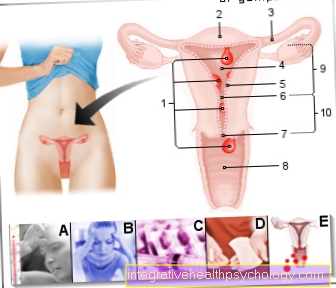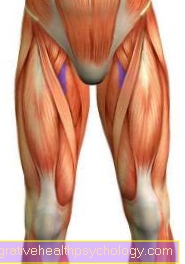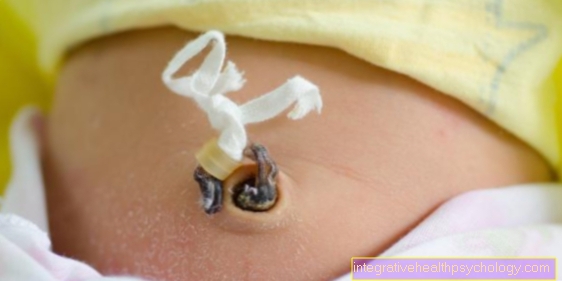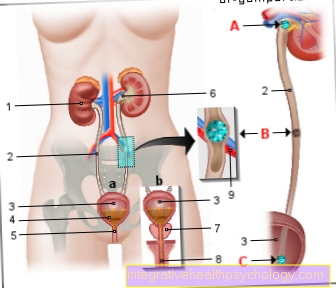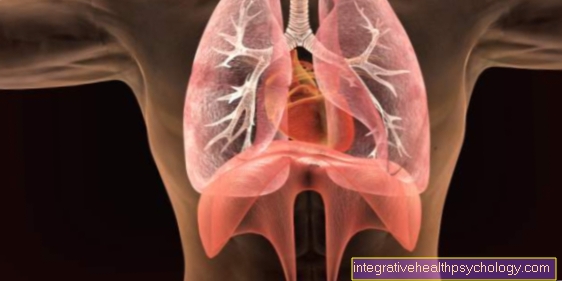Reasons for an amputation
introduction
An amputation, i.e. the removal of a limb, can have many different causes. A distinction is made between an amputation injury e.g. in the event of an accident and an amputation that becomes necessary due to another illness.

The causes of an amputation are diverse, as are the amputation sites.
If the lower leg has to be surgically removed, the cause is usually diabetes mellitus; if it affects the upper extremity, accidents are more common.
On the one hand, the causes can be traumatological - that is, the accident as the cause.
After injuries, e.g. in a car accident with severe damage:
- of the soft tissue covering
- blood circulation
- and the skeleton
a limb, it is often no longer possible to preserve the injured part of the body.
A septic cause can be caused by an uncontrollable infection e.g. after an accident (trauma) or pathological tissue destruction (moist gangrene).
But amputation may also be necessary in the case of tumor diseases. In the case of uncontrollable, malignant soft tissue or bone tumors in the arms or legs (extremities), surgical removal can sometimes be unavoidable in order to prevent the tumor from progressing or even spreading.
However, amputation can also be helpful due to a severe functional limitation, such as is the case with a rigid and curved finger, which impairs the mobility of the hand and the other fingers, although at first thought it doesn't sound right. However, the functional restriction can be so severe that amputation of a finger makes sense.
Common causes of an amputation
The most common reasons for an amputation include angiological causes, i.e. diseases of the blood vessels. Irrecoverable circulatory disorders with soft tissue tissue destruction in the vicinity of larger blocked vessels due to calcification and narrowing of the arteries (arteriosclerosis) or also due to blockage due to a blood clot (embolism) are mostly causal.
Diabetic foot syndrome is often the reason for an amputation in diabetics. The peripheral neuropathy associated with the disease leads to nerve damage that is associated with sensory disturbances or abnormal sensations in the legs. The damage progresses slowly from the foot to the thigh. Together with the sensory disorder, there is also a reduced sensation of pain, which means that those affected do not feel any pain even under extreme stress, which is actually perceived by the body as a warning symptom of tissue destruction.
This discomfort has the consequence that incorrect pressure loads or incorrect shoes lead to skin defects (Ulcers) that are only noticed late.
It is the same with burns. The untreated skin lesions become inflamed, bacteria can colonize and can lead to massive changes with destruction of the soft tissue and bone tissue.
In addition to peripheral neuropathy, diabetics often suffer from peripheral arterial occlusive disease or diabetic microangiopathy, i.e. calcification of the small vessels.
Due to the calcification of the vessels, which leads to a restricted supply of the legs with oxygen and nutrients, an adequate supply of the tissue cannot be guaranteed under critical conditions such as pressure loads or injuries. As a result, wound healing disorders with tissue destruction (moist gangrene) arise, which can lead to complete death of the toes and later of the tissue overlying them.
Read more on the topic: Gangrene
Diabetes mellitus
In diabetes patients, two different processes in the body lead to the death of parts of the body that have to be amputated. The permanently high blood sugar in poorly controlled diabetics causes damage to the blood vessels. Defense cells that have been altered by sugar form plaques in the vessels and block the blood vessels. The body areas behind are no longer adequately supplied with oxygen and go under. Since undersupplied areas of the body create a breeding ground for bacteria, dead areas must be amputated generously.
In addition to the blood vessels, the nerves are also damaged. Damaged nerves mean that those affected have a reduced sensitivity to pain in the feet. Small wounds, for example from poorly fitting shoes, are not noticed and spread. In combination with the poor blood circulation, there are wound healing disorders and infections, which in turn can make amputation necessary. For those affected, an operation is often not enough; the feet are gradually amputated. Prevention is only possible through consistent blood sugar regulation and regular foot care. The diabetic foot is one of the most common reasons for amputations in Germany.
Read more on this topic at: Consequences of diabetes
Circulatory disorders
Every cell in our body needs oxygen to survive. This is transported to the cells via the blood vessels. If this transport route is blocked, the body region behind the blockage dies. Circulatory disorders can have very different causes. With diabetes or high cholesterol levels, blood vessels throughout the body are damaged and plaque builds up in the vessels. Thrombi then form at these narrow points, which can be flushed into smaller vessels and get stuck there.
Some infectious diseases also lead to thrombus formation, which can make amputations necessary. Some people also have congenital blood clotting disorders. This means that the blood forms clots on its own and obstructs vessels.
One of the most common reasons for thrombi is an abnormal heart rhythm called atrial fibrillation. The atria contract in an uncontrolled manner and the changed flow in the heart leads to the blood clumping. These thrombi can trigger strokes, heart attacks or even vascular occlusions in the legs and arms. If the treatment is too late, they must be amputated. Timely treatment can often prevent this.
Accidents
When most people think of amputations, the first thing they think about is serious accidents. These are probably the most extreme cases, as there is no illness at all and the amputation is a sudden event. Fortunately, amputations after accidents are not the norm. Even limbs that have already been separated from the body as a result of the accident can be sewn back on.
So on the one hand there are those affected who have already lost limbs as a result of the accident, which cannot be sewn on again. These are so-called amputation injuries. On the other hand, there are serious injuries in which the tissue is so badly damaged that surgical amputation is necessary. There are also possible infections after an accident, especially if the wound has been contaminated.
Amputations after accidents often have a good prognosis for residual limb healing and thus the possibility of wearing prostheses, since the body is healthy and does not just shift the problem, as is the case with circulatory disorders. Close psychological support is important for those affected, as they are suddenly thrown into a completely new life situation.
Fingers are often affected by traffic accidents or deep cuts in the kitchen. If the finger can no longer be preserved, it must be amputated.The loss of a finger usually affects the affected person more than an amputated toe.
Read on below: Amputation of a finger
Inflammation / infection
After minor injuries, for example when gardening, bacteria can get into the wound and lead to major inflammation. In some cases, only amputation can prevent the inflammation from spreading. This occurs especially with resistant germs.
An extreme example of a gas fire infection. Environmental germs called Clostridium perfringens penetrate the skin through wounds, especially bruises, with severe tissue damage. The bacteria eat their way through the tissue and destroy blood vessels. A life-threatening spread of the germ can only be prevented by a large-scale amputation.
Even germs that affect the whole body can make amputations necessary due to thrombus formation. The bigger and dirtier a wound, the more likely it is to be contaminated with dangerous bacteria. The risk of infection is increased especially after serious accidents, animal bites and burns.
There are many pathogens in cat saliva that can lead to severe inflammation and infections even with small bite wounds and thus make an amputation necessary. For these reasons, it makes sense to have a check-up at your doctor's office even with small wounds. The tetanus vaccination protection must also be considered. Amputation is always the last resort and is only used when the life of the person concerned is in danger.
After an insect bite
Usually, bites from insects, such as mosquitoes or wasps, do not lead to major infections. In some cases, however, an allergy can lead to more severe consequences than the normal wheal. If the bacterium Streptococcus pyogenes is transmitted during the bite, it can lead to what is known as necrotizing fascitis. This means that the shell of the muscles becomes inflamed and dies. The blood vessels are compressed by the swelling and an amputation may be necessary. However, this severe course is very rare.




